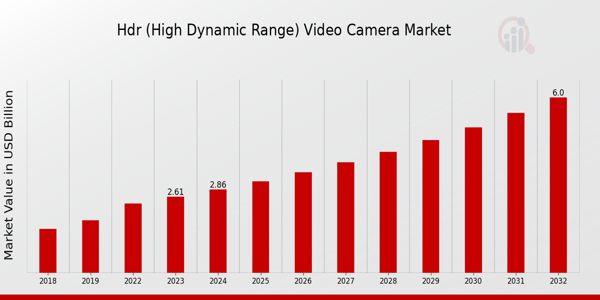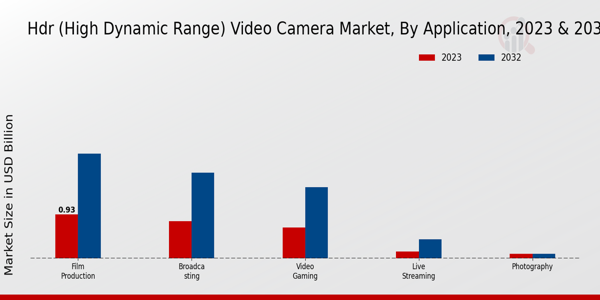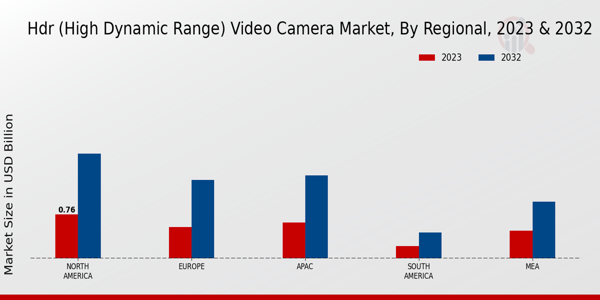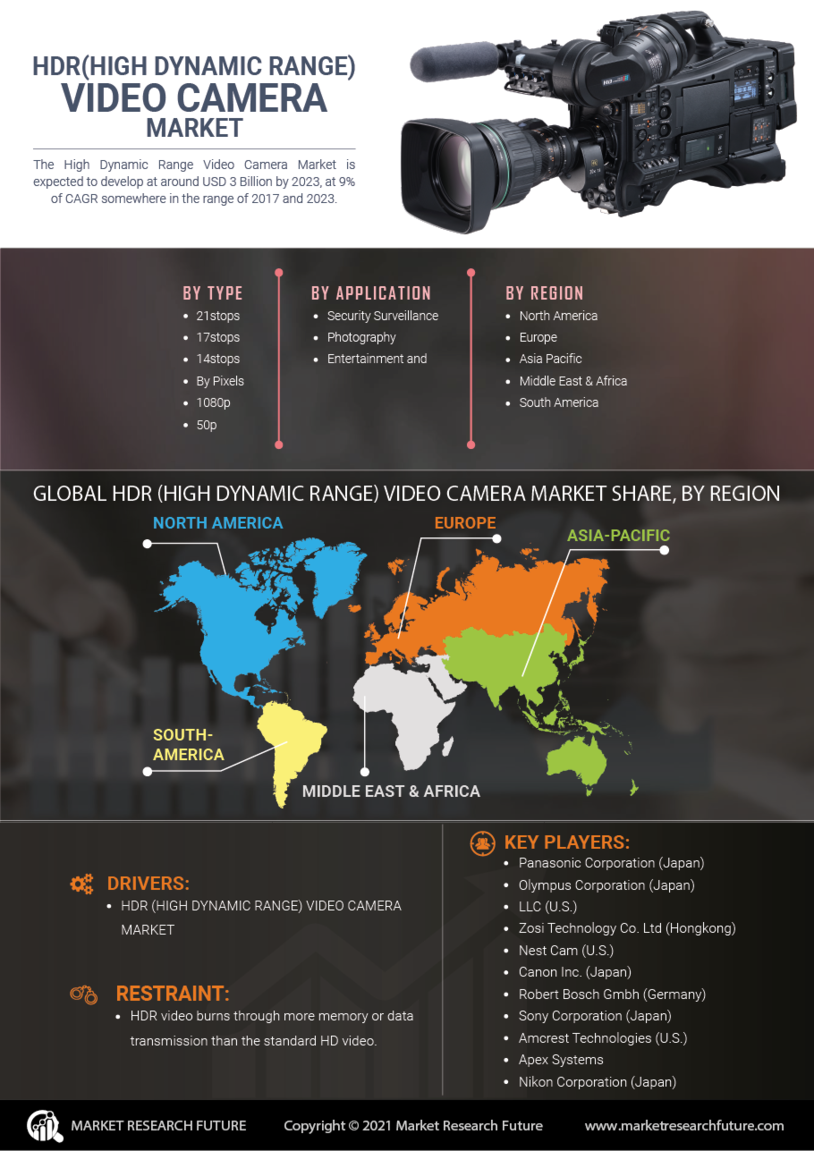HDR Video Camera Market Summary
As per Market Research Future Analysis, the Global HDR Video Camera Market was valued at 2.38 USD Billion in 2022 and is projected to grow to 6.0 USD Billion by 2032, reflecting a CAGR of 9.7% from 2024 to 2032. The market is driven by the increasing demand for high-quality video content across various sectors, including entertainment and education, alongside technological advancements in camera features.
Key Market Trends & Highlights
The HDR Video Camera Market is witnessing significant growth due to various factors.
- Market size in 2023: 2.61 USD Billion; projected to reach 6.0 USD Billion by 2032.
- Film Production segment valued at 0.93 USD Billion in 2023; expected to rise to 2.2 USD Billion by 2032.
- North America leads with a market valuation of 0.759 USD Billion in 2023; expected to grow to 1.8 USD Billion by 2032.
- Rising demand for enhanced video quality across sectors like filmmaking, gaming, and live broadcasting.
Market Size & Forecast
2022 Market Size: USD 2.38 Billion
2023 Market Size: USD 2.61 Billion
2032 Market Size: USD 6.0 Billion
CAGR (2024-2032): 9.7%
Largest Regional Market Share in 2023: North America.
Major Players
Key players include Blackmagic Design, Panasonic, Samsung, Arri, GoPro, Apple, Nikon, Sony, and Canon.
Key HDR (High Dynamic Range) Video Camera Market Trends Highlighted
The HDR Video Camera Market is experiencing significant growth driven by the increasing demand for high-quality video content across various industries, including entertainment, advertising, and education. The rise of streaming services and social media platforms has led to a greater need for cameras that capture vivid colors and exceptional clarity. This push for better visuals is a major factor stimulating market expansion. Furthermore, technological advancements in camera sensors and image processing are enhancing HDR capabilities, making these cameras more appealing to content creators and professionals. There are numerous opportunities to be explored within this evolving market.
As more industries recognize the value of HDR video, companies have the chance to develop innovative solutions and products tailored to specific needs. For instance, the integration of HDR technology in smartphone cameras represents a growing niche. Furthermore, there is potential for collaborations between camera manufacturers and software developers to create solutions that optimize HDR video workflows. Exploring emerging markets could also provide substantial growth avenues, especially as more consumers seek video production tools for personal use. In recent times, there has been a noticeable trend toward increased consumer awareness about video quality and image aesthetics.
Content creators are not merely looking for tools; they seek cameras that deliver professional results without requiring extensive technical skills. Additionally, the prevalence of user-generated content has shifted the focus toward compact and portable cameras that support HDR features, making it accessible to a broader audience. The convergence of various technologies, including artificial intelligence and machine learning, is also shaping the HDR video camera landscape, enhancing automation and improving user experience significantly.

Source: Primary Research, Secondary Research, MRFR Database and Analyst Review
HDR (High Dynamic Range) Video Camera Market Drivers
Rising Demand for Enhanced Video Quality
The HDR (High Dynamic Range) Video Camera Market Industry is currently experiencing a significant surge in demand for enhanced video quality. As consumers and professionals alike are becoming increasingly discerning about image and video quality, the need for solutions that offer superior dynamic range and vibrant color reproduction has intensified. This demand spans various sectors, including filmmaking, gaming, live broadcasting and streaming services, all of which are elevating the standards of visual content.
With the anticipated growth of the industry, manufacturers are focusing on developing HDR video cameras that cater to both amateur and professional users. This includes advancing technology that allows for improved sensor performance, greater color accuracy and higher frame rates. The commitment to improving video quality is particularly crucial as platforms and audiences shift towards ultra-high-definition content. Consumers expect their devices to support the latest advancements in visual technology, and the HDR (High Dynamic Range) Video Camera Market is positioning itself to meet these expectations.
Companies are investing in research and development to create cameras that simultaneously enhance HDR capabilities while being user-friendly and accessible to all levels of filmmakers. With ongoing advancements in processing power, lens technology, and sensor capabilities, the industry is poised to deliver cameras that not only meet current demands but also push the boundaries of possibility in video quality. Enhanced video quality is, therefore, not merely a trend; it is a foundational driver reshaping the market landscape today and into the future.
Growth of Content Creation and Streaming Services
The rise of content creation and streaming services has been a significant driver for the HDR (High Dynamic Range) Video Camera Market Industry. As platforms like YouTube, Netflix and Twitch continue to gain massive popularity, the demand for high-quality video production has increased dramatically. Content creators require advanced cameras to deliver visually stunning and captivating content that attracts viewers. This trend is not only limited to professional creators but also includes hobbyists, which broadens the market scope.
The growing need for HDR content across platforms is prompting camera companies to come up and develop ways to meet the expectation of the consumers.
Technological Advancements in Camera Features
Technological advancements in camera features significantly contribute to the growth of the HDR (High Dynamic Range) Video Camera Market Industry. Innovations in camera technology, such as enhanced sensors, improved image processing capabilities, and advanced autofocus systems, have made it easier for users to capture high-quality HDR footage. This ongoing evolution in technology allows for greater creative control and results in professional-grade outputs, attracting both professionals and enthusiasts to embrace HDR video cameras.
HDR (High Dynamic Range) Video Camera Market Segment Insights:
HDR (High Dynamic Range) Video Camera Market Application Insights
The HDR (High Dynamic Range) Video Camera Market is experiencing notable growth in its Application segment, projected to reach a value of 2.61 USD Billion in 2023 and escalate to 6.0 USD Billion by 2032. The increasing demand for high-quality video content highlights the importance of this market's segmentation, including key applications such as Film Production, Broadcasting, Video Gaming, Live Streaming and Photography.
Film Production leads this segment with significant revenue, valued at 0.93 USD Billion in 2023 and expected to rise to 2.2 USD Billion in 2032, driven by the industry's constant quest for improved visual appeal and enhanced storytelling. Broadcasting follows with a valuation of 0.78 USD Billion in 2023, projected to grow to 1.8 USD Billion by 2032, reflecting a notable shift towards high-definition content delivery and audience engagement.
The Video Gaming sector also plays a vital role in the HDR (High Dynamic Range) Video Camera Market, valued at 0.65 USD Billion in 2023 and anticipated to reach 1.5 USD Billion by 2032, as gaming companies increasingly integrate high-quality visuals to enhance user experience. Live Streaming, though currently valued at 0.15 USD Billion in 2023, is steadily gaining traction, with a projected increase to 0.4 USD Billion by 2032, fueled by the rapid growth of platforms that allow real-time broadcasting and interaction.
Lastly, the Photography application remains stable, with a value of 0.1 USD Billion, reflecting niche usage in HDR photography techniques but showing limited growth potential compared to other segments.
Overall, the HDR (High Dynamic Range) Video Camera Market data suggests a vibrant and evolving industry landscape where Film Production and Broadcasting dominate the revenue share due to higher investment in technology and viewer demand for superior quality. The growth drivers include advancements in camera technologies, increasing consumption of high-definition content, and the rising popularity of streaming platforms and interactive gaming, which present ample opportunities for market expansion. However, challenges like intense competition and the need for continuous innovation remain pivotal factors impacting market dynamics.
With a solid annual growth rate ahead, segments emphasizing high-definition quality will likely continue to drive the market forward, creating an array of prospects for stakeholders across the HDR (High Dynamic Range) Video Camera Market industry.

Source: Primary Research, Secondary Research, MRFR Database and Analyst Review
HDR (High Dynamic Range) Video Camera Market Camera Type Insights
The market is primarily segmented into various camera types, which play a crucial role in catering to different consumer needs and preferences. DSLR and mirrorless cameras are particularly significant due to their versatility and high image quality, making them popular among both professionals and enthusiasts. Additionally, camcorders are favored for their ease of use and ability to produce extended footage, appealing to content creators.
Action cameras have carved out a unique niche by enabling users to capture high-quality videos in adventurous settings, thereby driving demand for extreme sports and outdoor activities. Smartphone cameras dominate a substantial portion of the market as they offer convenience and accessibility, enabling users to record and share quality footage instantly. The steady evolution of technology and increasing consumer interest in high-quality video capture contribute positively to the HDR (High Dynamic Range) Video Camera Market revenue.
HDR (High Dynamic Range) Video Camera Market End Use Insights
This market's segmentation by end use encompasses various applications, including the Professional, Amateur and Educational sectors, each contributing uniquely to overall market revenue. The Professional segment dominates the market due to the increasing demand for high-quality video content in industries such as filmmaking and broadcasting, where HDR capabilities are crucial.
Meanwhile, the Amateur segment is gaining traction as more individuals pursue content creation through vlogging and social media, reflecting a shift towards personal storytelling and creativity. The Educational segment also plays a significant role, leveraging HDR technologies for enhanced learning experiences and immersive content within academic institutions. As the industry evolves, key growth drivers such as technological advancements, improved accessibility of equipment, and growing consumer interest in high-quality visual media will shape the landscape of the HDR (High Dynamic Range) Video Camera Market, presenting abundant opportunities to stakeholders.
HDR (High Dynamic Range) Video Camera Market Connectivity Insights
The integration of Wi-Fi, Bluetooth, HDMI, and USB-C technologies plays a crucial role in enhancing user experience and functionality. Wi-Fi connectivity allows for seamless streaming and sharing capabilities, meeting the demand for real-time broadcasting. Bluetooth features enable quick and reliable pairing with mobile devices, enhancing flexibility for users. HDMI is significant for high-quality video transmission and vital for professional applications, while USB-C has emerged as a preferred choice for fast data transfer and charging, creating convenience for users.
The growing reliance on these connectivity options is a major contributor to the market's revenue, with increasing consumer preference for versatile and high-performing video-capturing solutions. Moreover, advancements in these areas present substantial growth opportunities, catering to the evolving needs of content creators and professionals in the industry, further driving the HDR (High Dynamic Range) Video Camera Market statistics into a promising future.
HDR (High Dynamic Range) Video Camera Market Regional Insights
North America leads with a market valuation of 0.759 USD Billion in 2023, expected to grow to 1.8 USD Billion by 2032, making it a dominant player. The significant growth in this region is attributed to advanced technological adoption and high demand from content creators. Europe follows, with a valuation of 0.542 USD Billion in 2023, rising to 1.35 USD Billion in 2032, reflecting steady growth driven by a flourishing media industry.
The APAC region, valued at 0.615 USD Billion in 2023, is poised to reach 1.425 USD Billion in 2032, showcasing strong growth potential due to increasing investments in broadcast technology. South America shows smaller market figures at 0.217 USD Billion in 2023, with a potential increase to 0.45 USD Billion by 2032, indicating an emerging market fueled by increasing interest in HDR content. Lastly, MEA is valued at 0.477 USD Billion in 2023 and is expected to reach 0.975 USD Billion by 2032, supported by burgeoning media and entertainment sectors.
This landscape reflects varied growth dynamics and the strategic importance of each region within the HDR (High Dynamic Range) Video Camera Market industry.

Source: Primary Research, Secondary Research, MRFR Database and Analyst Review
HDR (High Dynamic Range) Video Camera Market Key Players and Competitive Insights:
The HDR (High Dynamic Range) Video Camera Market has been experiencing a notable transformation driven by advancements in technology, changing consumer demands, and the rising popularity of high-resolution video content across various platforms. With the growing focus on improving visual quality, video camera manufacturers are continually innovating to create products that deliver exceptional viewing experiences. The competitive landscape is characterized by a range of established players and emerging entrants who are leveraging technological advancements, strategic partnerships, and marketing strategies to capture market share.
As consumer preferences shift towards more immersive and lifelike experiences in filming and broadcasting, companies in this sector are adapting their product offerings to meet these dynamic demands, thereby influencing market growth trajectories.
Blackmagic Design is a key player in the HDR Video Camera Market, renowned for its innovative and versatile products designed to cater to professional filmmakers, content creators, and broadcast institutions. The company has established a strong market presence with its focus on high-quality video equipment that seamlessly integrates advanced HDR capabilities, appealing to both high-end cinema productions and independent creators alike. Blackmagic Design excels in offering an array of cameras that feature superior dynamic range, vibrant color science, and affordability without compromising on performance, setting it apart from other competitors.
The company's commitment to continuous improvement and understanding the needs of its diverse customer base has allowed it to build a loyal following, underpinned by exceptional after-sales support and an active community of users that strengthens its influence in the market.
Panasonic has also solidified its position within the HDR Video Camera Market by combining innovative technology with reliability, especially in professional and industrial segments. The company's dedication to quality is evident in its extensive range of video cameras, which are equipped with cutting-edge HDR features that enhance color depth and contrast, making them ideal for cinematic productions and high-standard broadcasting. Panasonic's strong reputation in the electronics market further amplifies its reach, as the brand is well-respected among cinematographers and videographers for its dependable products and groundbreaking innovation.
Additionally, the company focuses on the continual improvement of its technology and expanding its horizons in the HDR segment, ensuring that it meets the evolving expectations of the industry while remaining competitive against other key players.
Key Companies in the HDR (High Dynamic Range) Video Camera Market Include:
HDR (High Dynamic Range) Video Camera Industry Developments
Recent developments in the HDR Video Camera Market reveal an ongoing focus on technological enhancements and consumer engagement. Companies like Blackmagic Design are pushing boundaries with advanced camera models that optimize HDR capabilities. Panasonic and Sony continue to innovate, leveraging their expertise in imaging technology to improve dynamic range performance. Samsung's venture into HDR content production has further spurred growth across the market, aligning with increasing consumer demand for high-quality visuals in streaming and cinematography.
Moreover, RED Digital Cinema and Canon are expanding their product lines, highlighting the importance of HDR in professional videography. GoPro remains significant in the action camera segment, with HDR features attracting a younger demographic keen on adventure filmmaking. Recent mergers and acquisitions have not been prominent; however, market valuations demonstrate a steady increase, notably with companies like Nikon and JVC consolidating their positions in HDR technology landscapes. The overall market is witnessing a rise in valuation, showcasing the strategic initiatives by these industry players to capitalize on the growing demand for high-dynamic range content across various platforms.
HDR (High Dynamic Range) Video Camera Market Segmentation Insights
HDR (High Dynamic Range) Video Camera Market Application Outlook
HDR (High Dynamic Range) Video Camera Market Camera Type Outlook
HDR (High Dynamic Range) Video Camera Market End Use Outlook
HDR (High Dynamic Range) Video Camera Market Connectivity Outlook
HDR (High Dynamic Range) Video Camera Market Regional Outlook
|
Attribute/Metric
|
Details
|
|
Market Size 2022
|
2.38 (USD Billion)
|
|
Market Size 2023
|
2.61 (USD Billion)
|
|
Market Size 2032
|
6.0 (USD Billion)
|
|
Compound Annual Growth Rate (CAGR)
|
9.7% (2024 - 2032)
|
|
Report Coverage
|
Revenue Forecast, Competitive Landscape, Growth Factors, and Trends
|
|
Base Year
|
2023
|
|
Market Forecast Period
|
2024 - 2032
|
|
Historical Data
|
2019 - 2023
|
|
Market Forecast Units
|
USD Billion
|
|
Key Companies Profiled
|
Blackmagic Design, Panasonic, Samsung, Filminute, Arri, GoPro, Apple, AJA Video Systems, Nikon, Microsoft, JVC, RED Digital Cinema, Sony, Canon, Dell
|
|
Segments Covered
|
Application, Camera Type, End Use, Connectivity, Regional
|
|
Key Market Opportunities
|
Growing demand for content creation, Advancements in camera technology, Increasing popularity in filmmaking, Rising adoption of gaming, Expansion of live streaming services
|
|
Key Market Dynamics
|
Increasing demand for quality content, Advancements in imaging technology, Growth in streaming services, Rising popularity of 4K/8K video, Expanding applications in diverse industries
|
|
Countries Covered
|
North America, Europe, APAC, South America, MEA
|
HDR Video Camera Market Highlights:
Frequently Asked Questions (FAQ):
The Global HDR Video Camera Market is expected to reach a value of 6.0 USD Billion by the year 2032.
In 2023, the Global HDR Video Camera Market was valued at 2.61 USD Billion.
The market is projected to grow at a CAGR of 9.7% from 2024 to 2032.
North America is expected to be the dominant region, reaching a value of 1.8 USD Billion by 2032.
The Film Production application is projected to reach a value of 2.2 USD Billion by 2032.
Major players include Blackmagic Design, Panasonic, Samsung, Arri, GoPro, Apple, Sony, and Canon, among others.
The Broadcasting application was valued at 0.78 USD Billion in 2023.
The Video Gaming application segment is anticipated to grow to 1.5 USD Billion by 2032.
The market in South America is expected to reach 0.45 USD Billion by 2032.
The Photography application was projected to remain valued at 0.1 USD Billion from 2023 to 2032.


















